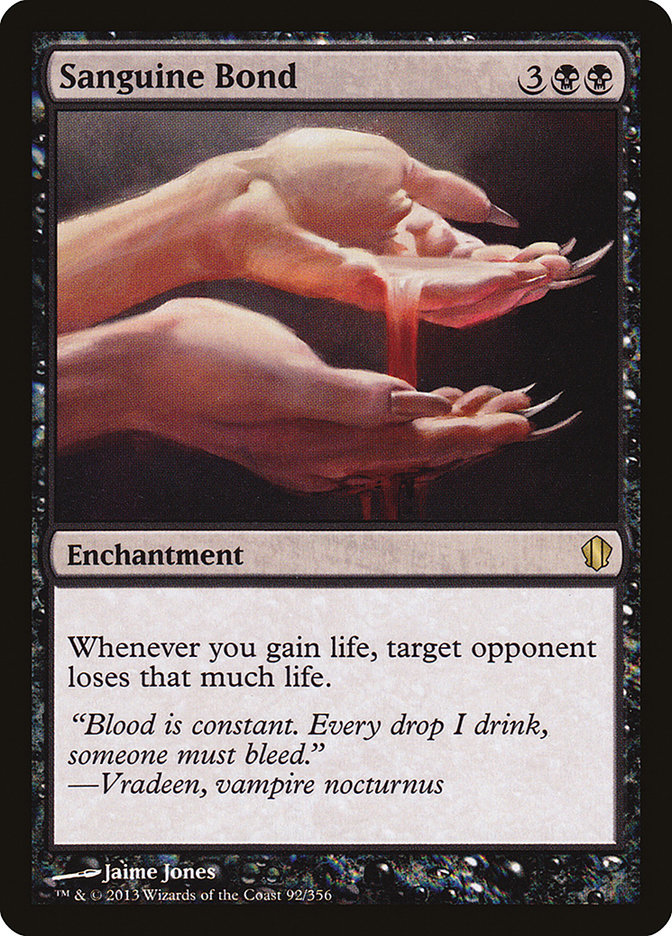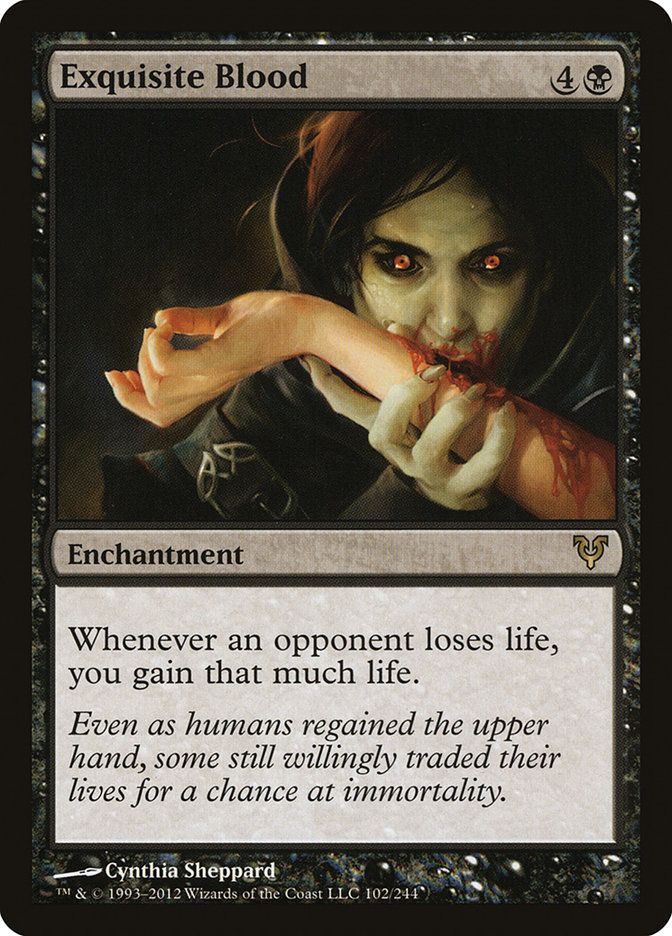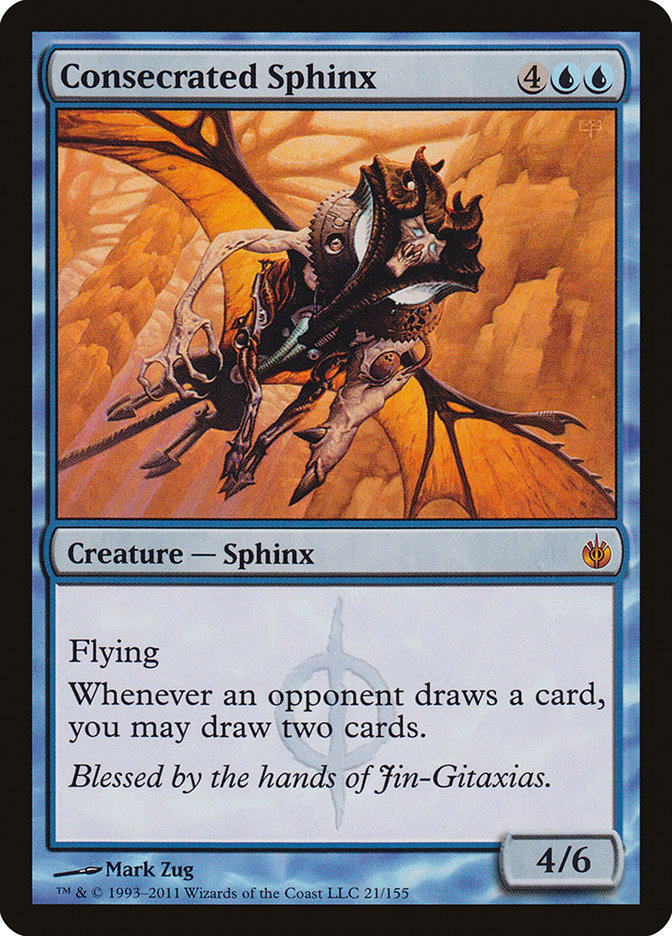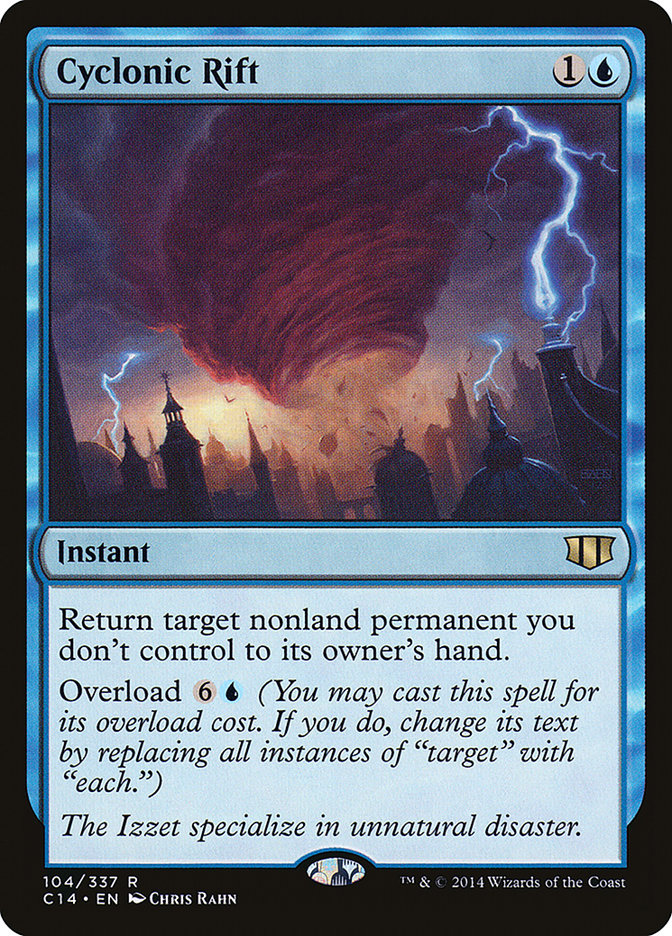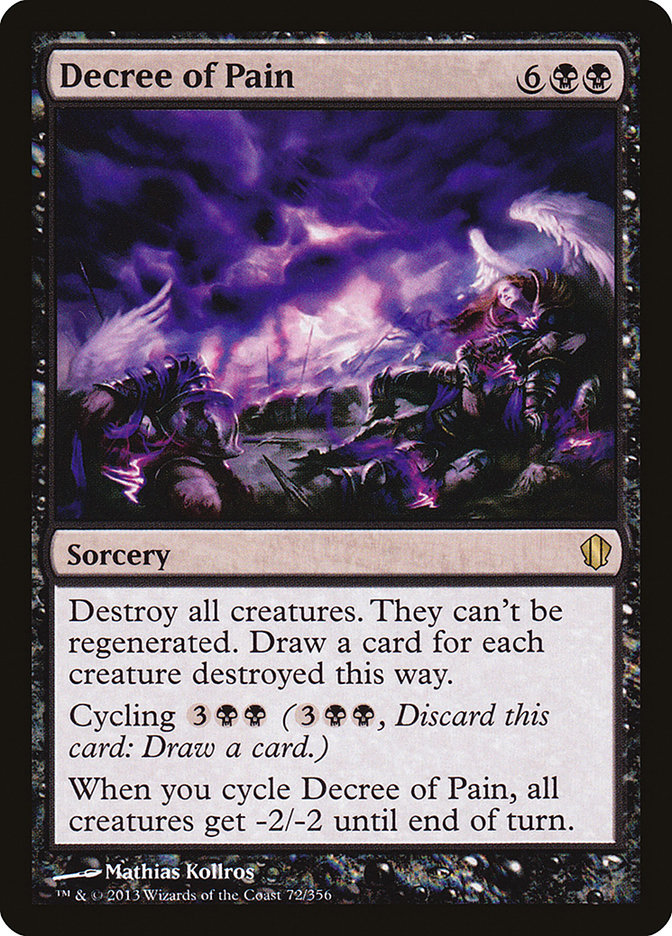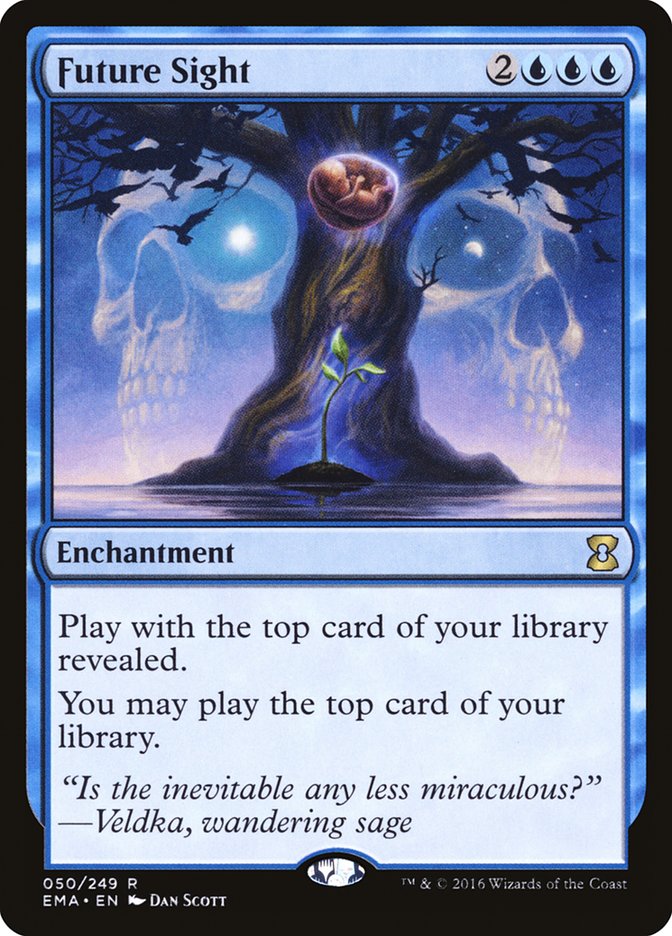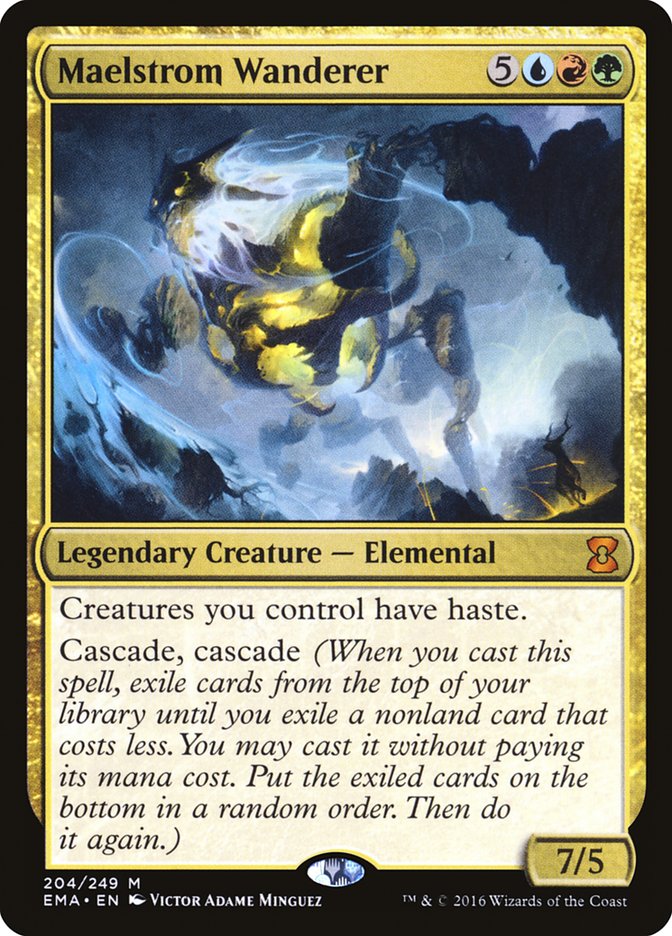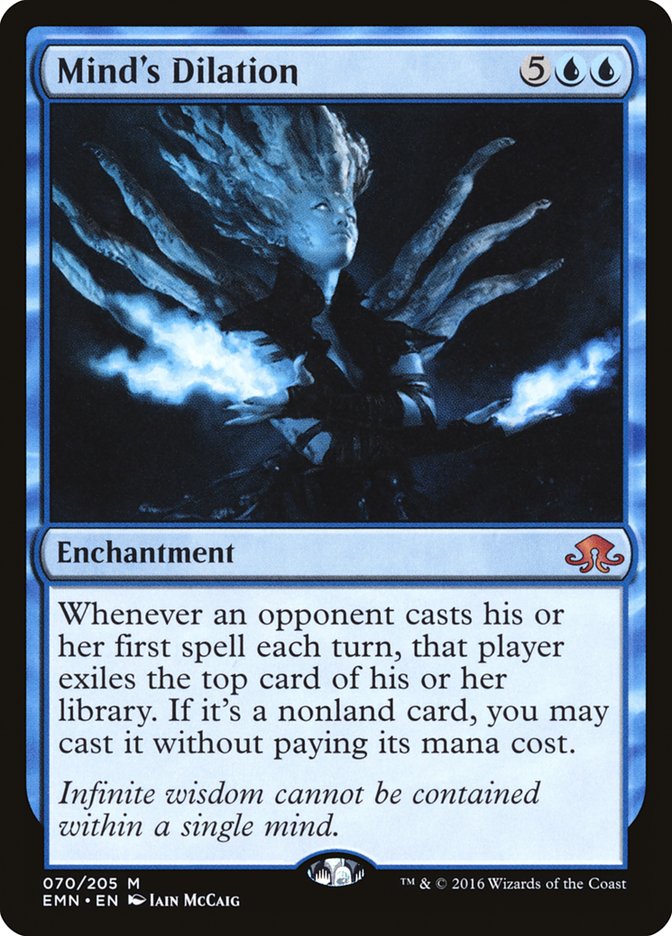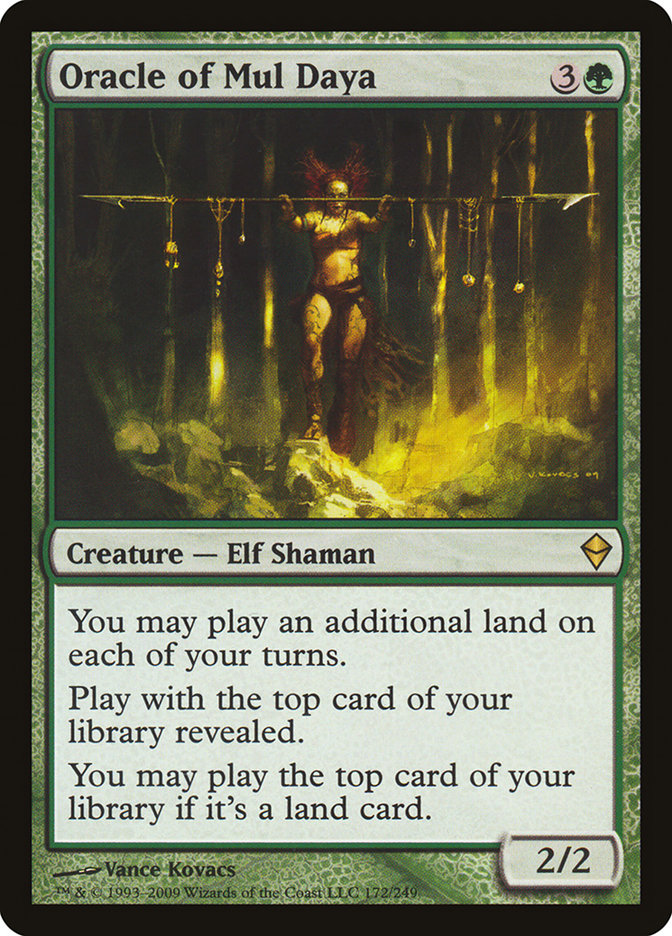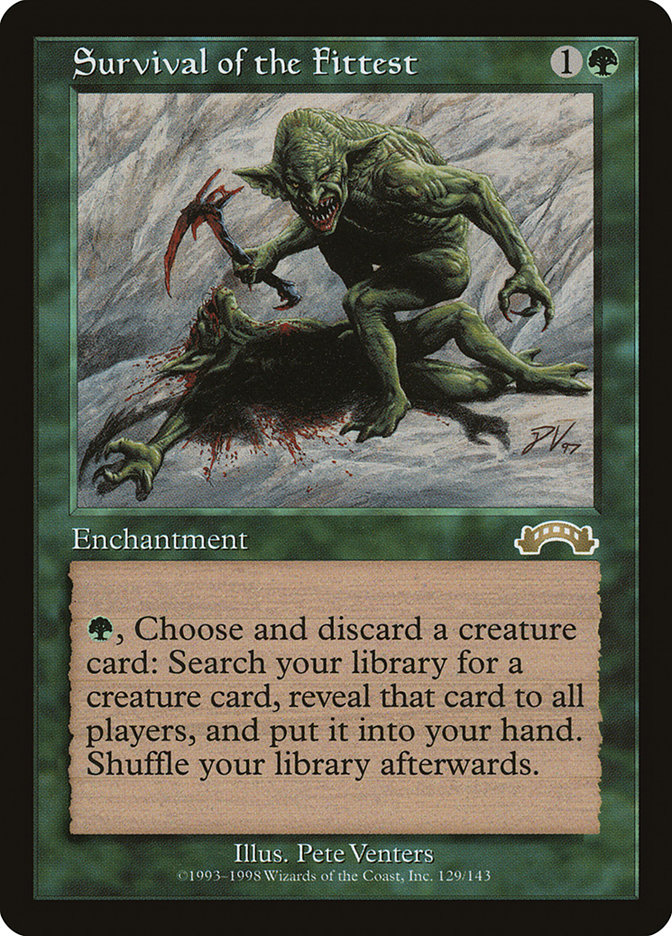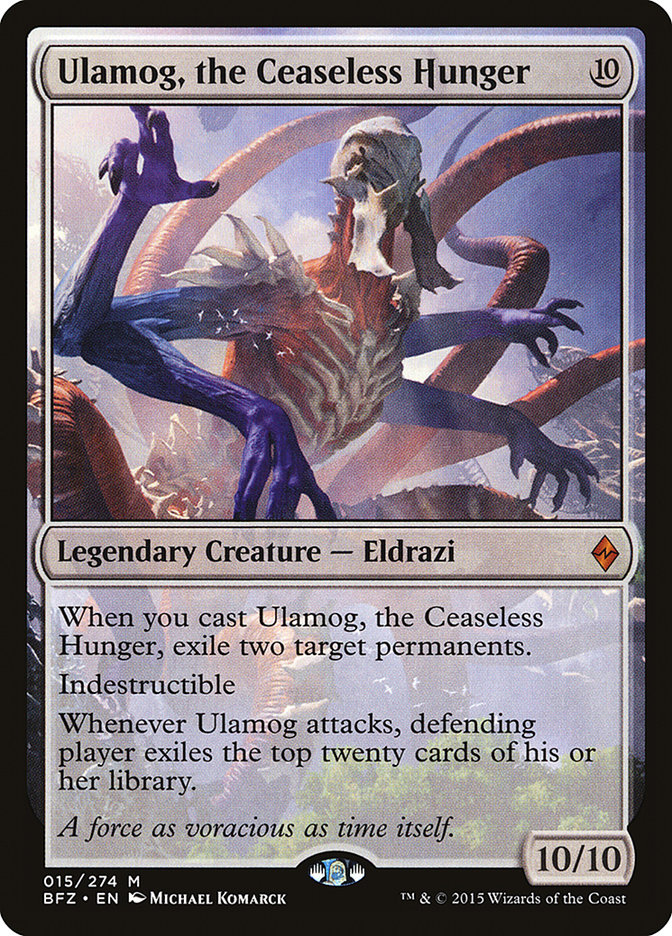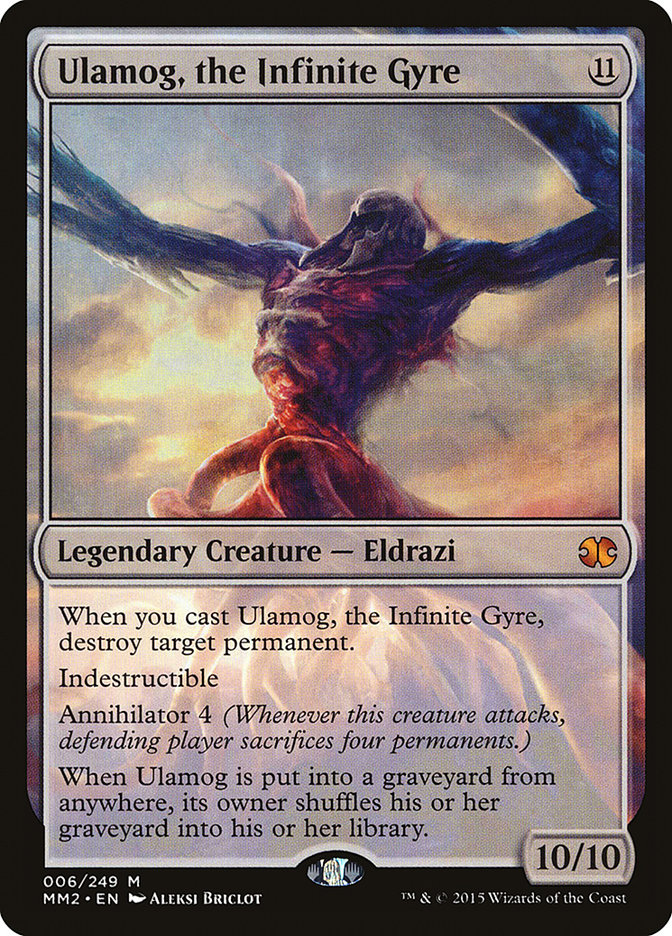We talk a great deal in Magic theory (and on these pages as it applies to Commander) about synergy—about combining two or more cards and getting a greater effect than the individual cards might produce. You’ll frequently hear things like “sure, that card is good in a burn deck” or “I wouldn’t play a control deck without it,” but those are how cards synergize with or into strategies. A single card strategy involves a card doing enough on its own to warrant consideration, nearly irrespective of the other cards in the deck, which is the context I would like to create here. This is, of course, a misnomer, because you can’t play any card without other cards in the deck (otherwise, it’s not a deck).
The idea of single card strategies is nearly as old as Magic itself, with an early book (1996 to be exact) dedicated to the idea. Back in 2012, Gavin Verhey wrote a nice piece on the mothership about them, although his discussion is based more around individual cards which are good enough to build a deck or decks around. What I’d like to talk about are cards which operate well in as much of a vacuum as we can create in the format. In this context, single card strategies are cards you want to consider playing because they’re going to do stuff you want—mostly independent of the rest of the deck’s strategy. I’m not talking about staples such as Solemn Simulacrum or Burnished Hart, but cards which, by the nature of what they do, are broadly strategic as opposed to narrowly.
An example of a narrow strategy is one card being not all that great without another. Sanguine Bond fits this category. It obviously does nothing unless you gain life. It synergizes with other cards which do gain you life, including a card you’ll see on the list: Exquisite Blood (more on that as we discuss the card). Single card strategies, then, take advantage of the things which will under normal circumstances frequently happen in the games in which we play. Maybe a better term for these is “self-contained single card strategies” (thanks to Joe Steet for the terminology suggestion). I crowd-sourced in advance a few ideas on what other folks thought might apply; where I’ve used their ideas, I’ve given them credit. I’m going to start with perhaps the card most emblematic of a single card strategy; the rest are listed in alphabetic order.
Perhaps the poster child for single card strategies, Consecrated Sphinx earns you benefits for doing what other players love to do—namely, drawing cards. The more they draw, the more you draw. You don’t need to do anything else in order for Consecrated Sphinx to do its thing. You can certainly do more to make it even better, but it’s not required. Even with just the normal draws, you’re plus six cards in a turn cycle (or plus eight in a five-player game). That’s a pretty serious advantage, and it’s one of the things which has led for some people to call for its banning. We on the Commander Rules Committee (RC) aren’t going to argue against its strength (we agree it’s pretty sweet); we just don’t think that it over-centralizes or devolves games sufficiently to warrant a ban. It’s a borderline card, for sure. In a situation in which we were comfortable with a 100-card banned list, Consecrated Sphinx would likely be on it. The idea of a 100-card banned list makes us quite twitchy, so I don’t think there’s any cause for alarm for you fans of arguably the most powerful of all the Sphinxes. Sphynges. Whatever they’re called.
As a Consecrated Sphinx side note, we have a penalty in our Rotisserie Draft League called “Dookie” (which is a carry-over from the earliest days of the Armada Games EDH League). It’s actually multiple things, the relevant one of which is drawing of your own accord ten or more cards in a single turn cycle (and your normal draw counts as one—and putting additional cards into your hand without drawing also counts). No one can force you into a dookie (like with Forced Fruition), but one sacrifice of Kozilek, Butcher of Truth to Greater Good will get it. It’s led to some strategically interesting choices—is taking the penalty worth trying to kill someone, since the points wash out? Sometimes yes, sometimes no. We’ve seen situations in which someone has stopped drawing from Consecrated Sphinx triggers or not sacrificed to Greater Good in order to limit the number of cards they draw (and therefore not get the penalty, or, like I did last week, stop before getting it a second time). Just like self-imposed deckbuilding limits make for more compelling builds, self-imposed game play choices can lead to more compelling games.
Whether you use it as an offensive or defensive weapon, Cyclonic Rift (overloaded, of course) always does heavy lifting. Regardless of the game you’re playing, Cyclonic Rift always gives you asymmetric value, since it simply can’t hit your permanents (without someone flashing in Dualcaster Mage or the like). There are those who would argue that this kind of asymmetry is exactly what should get Cyclonic Rift banned. The RC disagrees; especially since it keeps lands around, it seems fair enough. Extremely strong, but fair. Also a frequently repeated suggestion.
This is more a class of cards than one individual card; Decree of Pain is just the best example. I wouldn’t necessarily list Wrath of God effects as single card strategies, but “Wraths that do stuff” definitely fit the bill. Deadly Tempest, Martial Coup, and maybe even Necromantic Selection are other examples which fit into this class. I had initially considered Austere Command and Merciless Eviction as their own class, but I think their flexibility better fits them here. The “stuff” becomes “not get rid of what you want to keep.” Plague Wind and In Garruk’s Wake are also arguably members of this group.
Your opponents are going to lose life. It’s the nature of the game. Exquisite Blood does something immediately beneficial to you by raising your life total. Obviously, in Commander, a high life total isn’t the do all and end all, since commander damage can still kill you (ask me sometime about getting killed by Zedruu the Greathearted while at 2500+ life), but for the most part, gaining life makes you that much more difficult to kill. Mindcrank, which has the same trigger condition as Exquisite Blood, isn’t a single card strategy because you need something else in order to take advantage of the mill effect (since it takes more damage to mill out someone than to kill them without other factors involved).
Future Sight expands your hand. It falls into the category of what I call “effective card draw.” You’re not actually drawing cards (“draw” has a specific meaning in Magic), but it’s basically the same. For every card you play off the top of your library, you have another card available to play. In some cases (like when an opponent has Nekusar, the Mindrazer on the battlefield), effective card draw is even better. Whatever it is that you’re doing, Future Sight lets you do more of it. You might also consider Magus of the Future here, but its inherent weakness as a creature limits its usefulness without additional help (which, of course, then eliminates it from being a single-card strategy).
This one might be a more borderline call, since there’s a lower limit of number of creatures in your deck below which it’s not effective. For the most part (especially if you’re in green), you’re likely to be playing enough to make it worthwhile. Your opponents will definitely cast spells. If Lurking Predators either stops them from doing so or slows them down at all, it’s doing good work. I have a personal belief that you should just power through someone else’s Lurking Predators. Sure, sometimes they’re just going to win off the back of it—but not being proactive is just worse. Pro tip: Even if it seems like there’s a better strategic choice on the battlefield, when you Lurk into Clever Impersonator, the call is to copy Lurking Predators. Your future self, who will be telling stories of ridiculous things which happened in Commander games, will thank you.
Perhaps as close to Consecrated Sphinx as a defining card of this motif, Maelstrom Wanderer (especially as your commander) lets you do more of what you want to do, no matter what that is (obviously as long as it doesn’t cost eight or more). Although I already had it on my list, quite a few folks also suggested it.
I have Tampa’s own Matt Newnam to thank for reminding me about the blue version of Lurking Predators. What’s nice about Mind’s Dilation is that you also get to do what other people want to do—or at least prevent them from doing it (you don’t have to cast the card; if you don’t, it stays in exile). In the vein of doing what other people want to do, Villainous Wealth might also apply (thanks to George Efelis for that idea).
In Commander, everyone spends lots of mana (unlike other formats, such as Vintage or Legacy, in which you can make quite a bit happen on a little bit of mana). I list Mirari’s Wake first because it was the original (if we’re not counting Mana Flare, which doubles up everyone), but Mana Reflection; Vorinclex, Voice of Hunger; and Zendikar Resurgent count. I consider the latter the best of them all, but I also play loads of creatures. And friends don’t play Vorinclex with friends.
Like Future Sight, this is effective card draw, plus ramp to boot. There aren’t too many Commander strategies in which you want fewer lands on the battlefield, so the Oracle definitely applies. This was another popular suggestion.
A month ago, I was excited enough about this card to do some brainstorming about it. I’m even more excited about it now. It doesn’t matter what you’re doing with the spells you cast, you cast spells. Blue also happens to have the best instants, and you’re going to be playing a few of them anyway. You know what card would be bonkers with Rashmi? Prophet of Kruphix.
Once again, you’re playing green, so whatever you want to do with those creatures—whether it’s just being the beatdown or working into a combo of some kind, Survival of the Fittest will get you there. Sure, just like with Lurking Predators, there’s a lower creature count threshold at which it’s not particularly worthwhile to play it, but very few decks are going to be below that mark. Thanks to Scott Kasliner for the suggestion.
While you might argue for a few more of the Eldrazi to be added to these two, what separates them from the pack is that they’re indestructible. Other players will always have something which you want to blow up or exile. You’re then left with an enormous body to start bashing with. Both combat triggers are devastating and will start eliminating opponents in short order. Nick Rutkowski suggested Blightsteel Colossus in this vein; I hadn’t thought of it because Blightsteel Colossus is a card I’d rather forget exists.
Thanks to everyone on social media who chimed in with ideas for cards. There are certainly dozens more than I’ve listed here which could fit the bill, and I’m sure that many of you will come up with cool ideas of your own.
By now, I’m sure you’ve seen the September 2016 update (if you haven’t, we didn’t ban or unban anything). I want to mention the removal of the house rules section of the official web site. The overarching idea is about clarification and simplification, but it was particularly directed at sideboards (or Wish Boards, as some folks call them).
There was a time when sideboards were part of the format. We got rid of them because of the non-competitive nature of the direction we want the format to go. Unfortunately, because they were listed on the official site (even though they were clearly under the heading of House Rules, which were optional, not official), some folks still believed they were a baseline part of the format. Some would even use the House Rule listing as a method of bullying people into letting them use said Wish Boards. The clear message I’d like to send out here is that sideboards are not part of official Commander. If someone insists otherwise, point them to me or any other RC member. All that said, if your local group gets agreement on using them (or any other House Rule, quite honestly), we support you in doing so. When it comes to House Rules, I’d like to offer that the best course is consensus-building, not rules-lawyering.
Last Week’s Comments
Brad Pace mentioned that the Chromatic Project has inspired him to do one of his own and he’s up to 21 of the 27 (so congrats!). He also notes that we’ll soon have five new combinations to work on when the Commander 2016 product hits the shelves. Like Brad (and I’m sure lots of the rest of you), I’m looking forward to those new commanders. In fact, our next Rotisserie Draft League will be based around them. You’ll obviously be hearing lots more about that.
As I was musing about what cards from Kaladesh I’m going to put into my decks, Chris Ingersoll said, “I hope to one day live the dream of activating Aetherflux Reservoir while I have a Tainted Sigil on the battlefield.” We all do, Chris. We all do.
This Week’s Deck Without Comment is Adun’s Toolbox.
Creatures (36)
- 1 Ink-Eyes, Servant of Oni
- 1 Solemn Simulacrum
- 1 Kiki-Jiki, Mirror Breaker
- 1 Kokusho, the Evening Star
- 1 Withered Wretch
- 1 Wood Elves
- 1 Genesis
- 1 Undead Gladiator
- 1 Eternal Witness
- 1 Molder Slug
- 1 Grave-Shell Scarab
- 1 Burning-Tree Shaman
- 1 Big Game Hunter
- 1 Masked Admirers
- 1 Shriekmaw
- 1 Fertilid
- 1 Acidic Slime
- 1 Butcher of Malakir
- 1 Terastodon
- 1 Massacre Wurm
- 1 Scavenging Ooze
- 1 Soul of the Harvest
- 1 Rubblehulk
- 1 Gruul Ragebeast
- 1 Zhur-Taa Druid
- 1 Shattergang Brothers
- 1 Eidolon of Blossoms
- 1 Grenzo, Dungeon Warden
- 1 Feldon of the Third Path
- 1 Flesh Carver
- 1 Swift Warkite
- 1 Zulaport Cutthroat
- 1 Corpse Augur
- 1 Matter Reshaper
- 1 Archfiend of Ifnir
- 1 The Scorpion God
Planeswalkers (2)
Lands (36)
- 1 Strip Mine
- 6 Forest
- 1 Karplusan Forest
- 3 Swamp
- 3 Mountain
- 1 Badlands
- 1 Darigaaz's Caldera
- 1 Tower of the Magistrate
- 1 Miren, the Moaning Well
- 1 Golgari Rot Farm
- 1 Overgrown Tomb
- 1 Gruul Turf
- 1 Skarrg, the Rage Pits
- 1 Stomping Ground
- 1 Blood Crypt
- 1 Terramorphic Expanse
- 1 Graven Cairns
- 1 Mosswort Bridge
- 1 Spinerock Knoll
- 1 Savage Lands
- 1 Reliquary Tower
- 1 Dragonskull Summit
- 1 Rootbound Crag
- 1 Kazandu Refuge
- 1 Bojuka Bog
- 1 Command Tower
- 1 Kessig Wolf Run
Spells (25)
- 1 Sol Ring
- 1 Goblin Bombardment
- 1 Rampant Growth
- 1 Kodama's Reach
- 1 Plague Wind
- 1 Oversold Cemetery
- 1 Decree of Pain
- 1 Compost
- 1 Victimize
- 1 Savage Beating
- 1 Insurrection
- 1 Survival of the Fittest
- 1 Greater Good
- 1 Pernicious Deed
- 1 Sudden Spoiling
- 1 Explore
- 1 Momentous Fall
- 1 Cultivate
- 1 Hunter's Insight
- 1 Feed the Pack
- 1 Dictate of Erebos
- 1 Bitter Revelation
- 1 Palace Siege
- 1 Descent of the Dragons
- 1 Lifecrafter's Bestiary
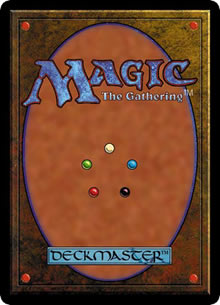
Check out our comprehensive Deck List Database for lists of all my decks:
SIGNATURE DECKS
Purple Hippos and Maro Sorcerers; Kresh Into the Red Zone; Halloween with Karador; Dreaming of Intet; You Did This to Yourself;
THE CHROMATIC PROJECT
Mono-Color
Heliod, God of Enchantments; Thassa, God of Merfolk; Erebos and the Halls Of The Dead; Forge of Purphoros; Nylea of the Woodland Realm; Karn, Beatdown Golem
Guilds
Lavinia Blinks; Obzedat, Ghost Killer; Aurelia Goes to War; Trostani and Her Angels; Lazav, Shapeshifting Mastermind; Zegana and a Dice Bag; Rakdos Reimagined; Glissa, Glissa; Ruric Thar and His Beastly Fight Club; You Take the Crown, I’ll Take Leovold; Gisa and Geralf Together Forever;
Shards and Wedges
Adun’s Toolbox; Animar’s Swarm; Karrthus, Who Rains Fire From The Sky; Demons of Kaalia; Merieke’s Esper Dragons; Nath of the Value Leaf; Rith’s Tokens; The Mill-Meoplasm; The Altar of Thraximundar; The Threat of Yasova; Zombies of Tresserhorn
Five-Color
THE DO-OVER PROJECT
Animar Do-Over; Karador Do-Over; Karador Version 3; Karrthus Do-Over; Mimeoplasm Do-Over; Phelddagrif Do-Over; Rith Do-Over; Ruhan Do-Over
If you’d like to follow the adventures of my Monday Night RPG group (in a campaign that’s been alive since 1987) which is just beginning the saga The Lost Cities of Nevinor, ask for an invitation to the Facebook group “Sheldon Menery’s Monday Night Gamers.”


